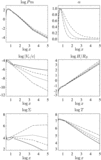Stability of MRI-turbulent Accretion Disks
Abstract
Based on the characteristics of the magnetorotational instability (MRI) and the MRI-driven turbulence, we construct a steady model for a geometrically thin disk using "non-standard" α-prescription. The efficiency of the angular momentum transport depends on the magnetic Prandtl number, Pm = ν/η, where ν and η are the microscopic viscous and magnetic diffusivities. In our disk model, Shakura-Sunyaev's α-parameter has a power-law dependence on the magnetic Prandtl number, that is α vprop Pm δ, where δ is the constant power-law index. Adopting Spitzer's microscopic diffusivities, the magnetic Prandtl number becomes a decreasing function of the disk radius when δ>0. The transport efficiency of the angular momentum and the viscous heating rate are thus smaller in the outer part of the disk, while these are impacted by the size of index δ. We find that the disk becomes more unstable to the gravitational instability for a larger value of index δ. The most remarkable feature of our disk model is that the thermal and secular instabilities can grow in its middle part even if the radiation pressure is negligibly small in the condition δ>2/3. In the realistic disk systems, it would be difficult to maintain the steady mass accretion state unless the Pm dependence of MRI-driven turbulence is relatively weak.
- Publication:
-
The Astrophysical Journal
- Pub Date:
- February 2011
- DOI:
- arXiv:
- arXiv:1011.4643
- Bibcode:
- 2011ApJ...727..106T
- Keywords:
-
- accretion;
- accretion disks;
- instabilities;
- magnetic fields;
- magnetohydrodynamics: MHD;
- Astrophysics - High Energy Astrophysical Phenomena
- E-Print:
- 9 pages, 6 figures, Accepted for publication in ApJ
